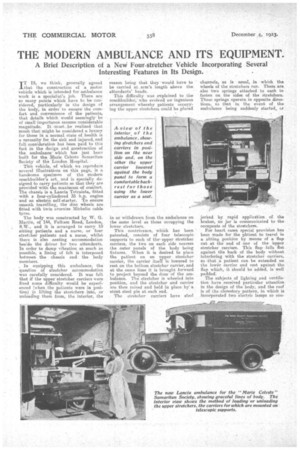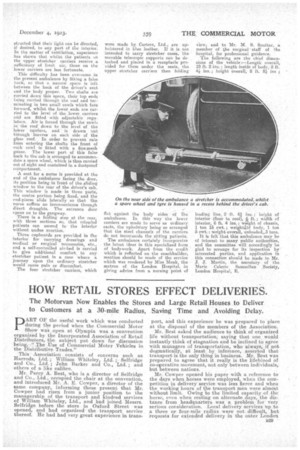THE MODERN AMBULANCE AND ITS EQUIPMENT.
Page 12

Page 13

If you've noticed an error in this article please click here to report it so we can fix it.
A Brief Description of a Ness i Four-stretcher Vehicle Incorporating Several Interesting Features in Its Design.
IT IS, we think, generally agreed that the construction of a motor vehicle which is intended for ambulance work is a specialist's job. There are so many points which have to be con: sidered, particularly in the design of the body, in order to ensure the comfort and convenience of taie patients, that details Which would seemingly be of small importance assume considerable magnitude. It ;must. be realized that much that might be considered a luxury for :those in a lamina' state of health is a •necessity for the sick and injured, and full: consideration has been paid to this fact in the design and construction of the ambulance.' which has just been built for the Marie Celeste Samaritan Society of the London Hospital.
This vehicle, of which we reproduce several illustrations on this page, is a handsome specimen of the modern coachbuilder's art, and is specially designed to carry patients so that they are provided with the maximum of comfort. The chassis is a Lands Tetraiota, fitted with a four-cylinderecl 35 h.p. engine and an electric self-starter. To ensure smooth travelling, the disc wheels are fitted with twin oversize Michelin cable tyres.
The body was constructed by W. G. Martin, of 144, Fulham Road, London, S.-W., and it is arranged to carry 10 sitting patients and a nurse, or four stretcher patients and a nurse, whilst there is also seating accommodation beside the driver for two attendants. In order to damp vibration as much as possible, a lining of felt is interposed between the chassis and the body members.
, In equipping this ambulance, the question of stretcher accommodation was carefully considered. It was felt that. if the upper'streteher carriers were fixed some difficulty would be experienced (when the patients were is position) in lifting the stretchers into, or unloading them from, the interior, the reason being that they 'would have to be carried at arm's length above the attendants' heads.
This difficulty was explained to the coachbuilder,' who evolved au ingenisus arrangement whereby patients occupying the upper stretchers could be placed in or withdrawn from the ambulance on the same level as those occupying the lower stretchers.
This contrivance, which has been patented, consists of four telescopic supports to each of theupper stretcher carriers, the two on each side nearest the outer panels of the body being fixtures. When it is desired to place the patient on an upper. stretcher carrier, the carrier itself is lowered to rest, on the bottom stretcher carrier, and at the same time it is brought forward to project beyond the doer of the ambulance. The stretcher is wheeled into position, and the stretcher and carrier are then raised and held in place bya stout steel pin at each end.
The strekher carriers have steel
channels, as is usual, in which the wheels of the stretchers run. There are also two springs attached to each to fasten on the sides of the stretchers. These springs operate, in opposite directions, so that in the event of the ambulance being suddenly started, or
jerked by rapid applicstion of the brakes, no jar is communicated to the occupants of the stretchers.
For heart cases special provision has been made for the phient to travel in a sitting position by means of a flap cut at the end of one of the Upper stretcher carriers. This flap falls flat against the back of the body without interfering with the stretcher carriers, So that a patient can be extended on the lower carrier and rest against the flap which, it should be added, is well padded.
The subjects of lighting and ventilation have received particular attention in the design of the body, and the roof is of the clerestory pattern, in which is incorporated two electric lamps so con steucted that their light can be directed, if desired, to any part of the interior. In the matter of ventilation, experience has shown that whilst the patients on the upper stretcher carriers receive a siifficiency of fresh air, those on the "lower carriers are less fortunate.
This difficulty has been overcome in the present ambulance by fitting a false back., so that a narrow space is left between the back of the driver's seat raid the body proper. Two shafts are carried down this space, their top ends being carried through the reef and ter minating in two small cowls which face forward, whilst the lower ends are carried to the level of the lower carriers mid are fitted with adjustable regulators. Air is forced through the cowls in the roof down to the levei of the. loWer carriers, and is drawn uut through louvres on each side of the glass roof. In order to prevent rain from entering the shafts the front of each cowl is fitted with a fine-mesh gauze. The lower part. of this false back to the cab is arranged to accommodate a spare wheel, which is thus carried out of sight and contained in a dustproof compartment,
A seat for a nurse is provided at the end of the ambulance facing the door, its position being in front of the sliding -window to the rear of the driver's cab. This window is made in three parts, the centre portion being fixed,and the end-pieces slide laterally so that the nurse suffers no inconvenience through direct draughts. The entrance door opens on to the gangway.
• There is a folding step at the rear, with three sections so, that crippled patients can ascend to • the interior without undue exertion.
Three cupboards are provided in theinterior for carrying dressings and medical or surgical necessaries, etc., and a self-controlled air-bed is carried to give additional comfort to any stretcher patient in a ease where a journey upon the ordinary stretcher would cause pain or discomfort.
The four stretcher carriers, which were made by Carters, Ltd., are upholstered in blue leather, If it is not intended to carry stretcher cases, the movable telescopic supports can be detached and placed in a receptacle provided for them under the seats, the upper stretcher carriers then folding
flat against the body sides of The ambulance. In this way the lower carriers are made to :serve as ordinary eeats, the upholstery being an arranged that the steel channels of the carriers do not incommode the sitting patients.
The ambulance certainly incorporates the latest ideas in this specialized form of bodywork. Apart from the credit which is reflected on the coachbuilder, mention should he made of the service which was rendered by Miss Monk, the matron of the Landon Hospital, in giving advice from a nursing point of view, and to Mr. M. S. Souttar, a member of the surgical staff of the hospital, for professional guidance.
The following are the chief dimensions of the vehicle :—Length overall, 19 ft. 2 ins.; length inside of body, 8 ft. 44 ins.; height overall, 8 ft. 8 ins ; loading line, 2 ft. 6qins.height of interior (floor to roof), § ft.; width of interior, 6 ft. 4 ins.; weight of chassis, 1 ton 15 cwt.; weigha,Of body, 1 ton 5 cwt. ; weight overall, unloaded,.3 tons.
It is felt that this ambulance may be of interest to many public authorities, and the committee will accordingly he glad to arrange for its inspection by interested parties, and application in this connection should be made to Mr. J. J. Martin, the secretary of the Marie Celeste Samaritan Society, London Hospital, E.


































